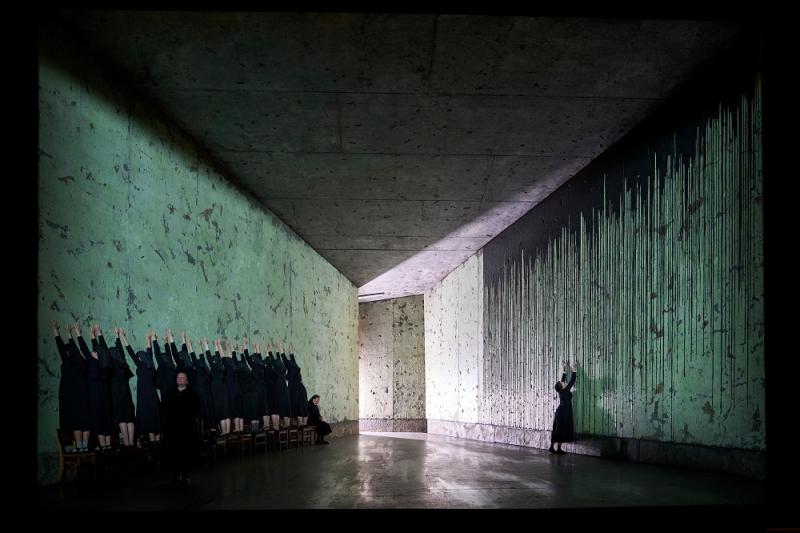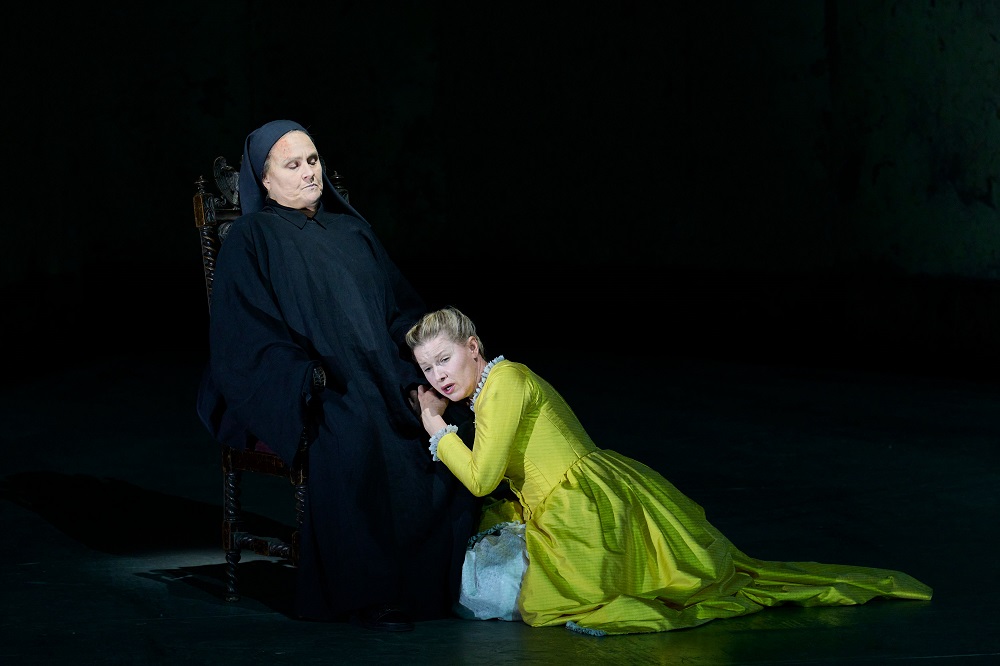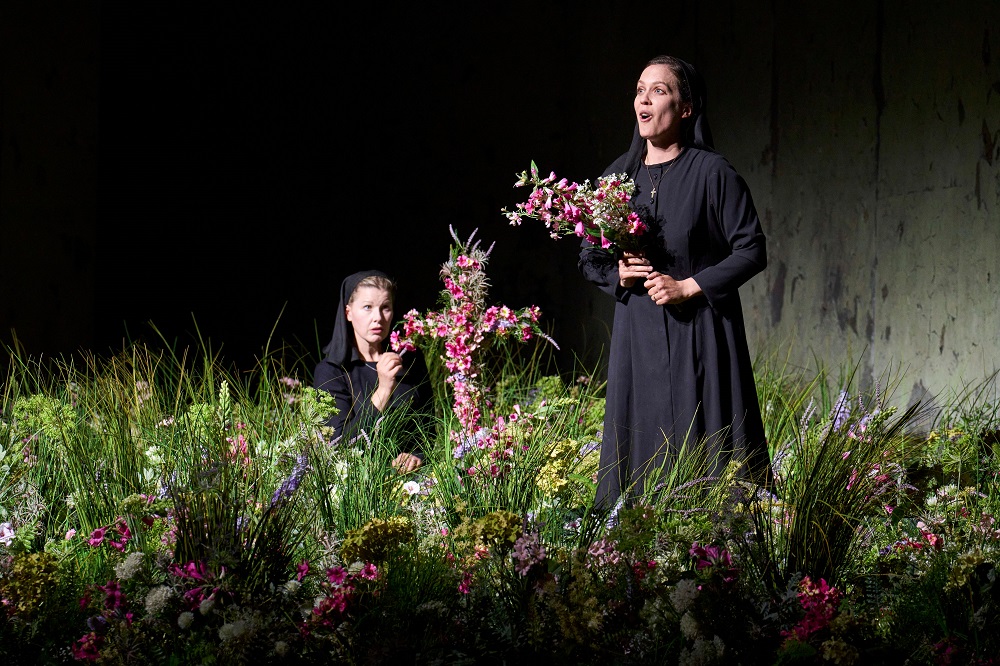Dialogues des Carmélites, Glyndebourne review - faith overwhelmed by horror | reviews, news & interviews
Dialogues des Carmélites, Glyndebourne review - faith overwhelmed by horror
Dialogues des Carmélites, Glyndebourne review - faith overwhelmed by horror
Strongest possible casting, directing and conducting sear the soul

Harrowing and holiness alternate in Poulenc’s unique masterpiece, nominally an opera about nuns during the French revolution, at a deeper level a music-drama about the greatest disturbances in the human condition. Glyndebourne’s cast, conductor and orchestra handle the variety wth total mastery. If Barrie Kosky’s production lets horror overwhelm us, that’s justified too. If you’re not a heap at the end of it, that’s your problem.
Kosky’s classic Handel Saul at Glyndebourne descended from flowery opulence to dust and ashes. His Dialogues starts with explosive dread against Katrin Lea Tag’s flaking walls, and only goes from bad to worse in terms of neurosis and upset, at least until the middle of Poulenc’s second act (vitally placed before the long interval; never has the leafy serenity of Glyndebourne’s setting seemed more at odds with the claustrophobic nightmare we’ve been experiencing). The dysfunctional de la Force household is charged with the director’s trademark physicality: it’s asking almost too much of singers rather than actors to express that, but Paul Gay’s Marquis, leaning almost Nosferatu-like against the left wall on curtain up - shadows, too, are always potent in Alessandro Carletti's lighting - and Valentin Thill as his furious, pacing son just about carry it off. We see that poor, fearful Blanche (Sally Matthews, vivid from the start), caught up in the intensity, has to get away from all this.  Fortunately the Kosky freneticism and occasional overload are stripped away as we enter the Carmelite convent (I have no problem with the time travel from the 18th century to the present from Scene 3 onwards, and unlike some, I'm not going to lament the electric iron). The torch of tension and human complexity is passed between five magnificently-cast women. I doubt if Danielle de Niese, originally cast as Blanche, good stage animal though she is, could have carried the demands with half the fire and thrust of Matthews, experienced in this difficult role. The spotlight is quickly on her (pictured above with Katarina Dalayman as the first Prioress), anxiety alternating with brave attempts at calm assurance.
Fortunately the Kosky freneticism and occasional overload are stripped away as we enter the Carmelite convent (I have no problem with the time travel from the 18th century to the present from Scene 3 onwards, and unlike some, I'm not going to lament the electric iron). The torch of tension and human complexity is passed between five magnificently-cast women. I doubt if Danielle de Niese, originally cast as Blanche, good stage animal though she is, could have carried the demands with half the fire and thrust of Matthews, experienced in this difficult role. The spotlight is quickly on her (pictured above with Katarina Dalayman as the first Prioress), anxiety alternating with brave attempts at calm assurance.
Matthews’ flaming upper register is vital, and in the close-to-endgame Act Three scene with Karen Cargill’s Mother Marie, it’s impossible to imagine greater intensity from both singer-actors. Cargill, the most beautiful deliverer of French music drama (I’m thinking of her Berlioz Cleopatra and longing for her Didon), has absolutely what it takes for this variegated character to move between almost fanatical adherence to the rules and maternal tenderness. Floris Valiquette is more than usually disconcerting as the usually just sweet Constance, Blanche’s fellow novice (one production point bothers me, though the mixing of centuries is fine and it isn’t realistic: shouldn’t the two novices be wearing white?) The tears started to flow not at the troubled end of the first Prioress – Katarina Dalayman, great Wagnerian, is still in fine voice, though allowed less tenderness than usual in Kosky’s concentration on the horror-story – but when Constance wonders if she got the wrong death. Unfolded against a visual interlude of a beautiful flower garden, this scene is intensely moving (pictured below).  Light also penetrates the darkness with the purposeful, smiling entry of the second Prioress Madame Lidoine: Golda Schultz has a natural radiance which informs this marvellous role. But following a brutal disruption of the cloistered life which, for all its dramatic force is a bit more musical-Les-Mis-like than realistic, the fear which had been Blanche’s destiny, and which is spreading, with justification, “like the cholera or the plague”, leaves no-one untouched, Lidoine included (Schultz and members of the Glyndebourne chorus pictured below). It makes her even more human; who wouldn’t falter at the horrifying treatment of the women in prison?
Light also penetrates the darkness with the purposeful, smiling entry of the second Prioress Madame Lidoine: Golda Schultz has a natural radiance which informs this marvellous role. But following a brutal disruption of the cloistered life which, for all its dramatic force is a bit more musical-Les-Mis-like than realistic, the fear which had been Blanche’s destiny, and which is spreading, with justification, “like the cholera or the plague”, leaves no-one untouched, Lidoine included (Schultz and members of the Glyndebourne chorus pictured below). It makes her even more human; who wouldn’t falter at the horrifying treatment of the women in prison?
Guiding us through the bewilderments is Robin Ticciati, alert to every shift of colour in this quietly remarkable score: extraordinary how Poulenc moves even in a single melodic line from one section of the orchestra to another. The lower tones are especially impressive from the London Philharmonic: bass clarinet eerily phosphorescent in the darkness, cellos and basses thrusting forward an especially despairing low ebb to a four-chord sequence which permeates the score. Ticciati has worked intensively with Kosky – the wonders of a long rehearsal period! – on the nature of the many silences, both daring to add more at the ends of scenes and before interludes played equally riskily in front of a black drop-curtain.  Maybe at times there’s a bit too much screaming in the gaps, but the later stages are more devastating than even Poulenc might have anticipated. The smaller male roles all help to turn the screw; none is less than well taken. Hair-shearing, objects including spectacles dropped into plastic bags: this is only the start of the inevitable end. I won’t spoil how Kosky deals with the “Salve regina” sung by ever-diminishing numbers of Carmelites on their way to the guillotine, but let’s say that where Robert Carsen’s equally remarkable staging emphasized the grace, this is comfortless. And when you have to stop yourself from sobbing out loud, you know it’s worked. Like the Poulenc double-bill which Ticciati conducted last season, this will go down as one of Glyndebourne’s most unforgettable achievements.
Maybe at times there’s a bit too much screaming in the gaps, but the later stages are more devastating than even Poulenc might have anticipated. The smaller male roles all help to turn the screw; none is less than well taken. Hair-shearing, objects including spectacles dropped into plastic bags: this is only the start of the inevitable end. I won’t spoil how Kosky deals with the “Salve regina” sung by ever-diminishing numbers of Carmelites on their way to the guillotine, but let’s say that where Robert Carsen’s equally remarkable staging emphasized the grace, this is comfortless. And when you have to stop yourself from sobbing out loud, you know it’s worked. Like the Poulenc double-bill which Ticciati conducted last season, this will go down as one of Glyndebourne’s most unforgettable achievements.
The future of Arts Journalism
You can stop theartsdesk.com closing!
We urgently need financing to survive. Our fundraising drive has thus far raised £49,000 but we need to reach £100,000 or we will be forced to close. Please contribute here: https://gofund.me/c3f6033d
And if you can forward this information to anyone who might assist, we’d be grateful.

Subscribe to theartsdesk.com
Thank you for continuing to read our work on theartsdesk.com. For unlimited access to every article in its entirety, including our archive of more than 15,000 pieces, we're asking for £5 per month or £40 per year. We feel it's a very good deal, and hope you do too.
To take a subscription now simply click here.
And if you're looking for that extra gift for a friend or family member, why not treat them to a theartsdesk.com gift subscription?
more Opera
 The Makropulos Case, Royal Opera - pointless feminist complications
Katie Mitchell sucks the strangeness from Janáček’s clash of legalese and eternal life
The Makropulos Case, Royal Opera - pointless feminist complications
Katie Mitchell sucks the strangeness from Janáček’s clash of legalese and eternal life
 First Person: Kerem Hasan on the transformative experience of conducting Jake Heggie's 'Dead Man Walking'
English National Opera's production of a 21st century milestone has been a tough journey
First Person: Kerem Hasan on the transformative experience of conducting Jake Heggie's 'Dead Man Walking'
English National Opera's production of a 21st century milestone has been a tough journey
 Madama Butterfly, Irish National Opera review - visual and vocal wings, earthbound soul
Celine Byrne sings gorgeously but doesn’t round out a great operatic character study
Madama Butterfly, Irish National Opera review - visual and vocal wings, earthbound soul
Celine Byrne sings gorgeously but doesn’t round out a great operatic character study
 theartsdesk at Wexford Festival Opera 2025 - two strong productions, mostly fine casting, and a star is born
Four operas and an outstanding lunchtime recital in two days
theartsdesk at Wexford Festival Opera 2025 - two strong productions, mostly fine casting, and a star is born
Four operas and an outstanding lunchtime recital in two days
 The Railway Children, Glyndebourne review - right train, wrong station
Talent-loaded Mark-Anthony Turnage opera excursion heads down a mistaken track
The Railway Children, Glyndebourne review - right train, wrong station
Talent-loaded Mark-Anthony Turnage opera excursion heads down a mistaken track
 La bohème, Opera North review - still young at 32
Love and separation, ecstasy and heartbreak, in masterfully updated Puccini
La bohème, Opera North review - still young at 32
Love and separation, ecstasy and heartbreak, in masterfully updated Puccini
 Albert Herring, English National Opera review - a great comedy with depths fully realised
Britten’s delight was never made for the Coliseum, but it works on its first outing there
Albert Herring, English National Opera review - a great comedy with depths fully realised
Britten’s delight was never made for the Coliseum, but it works on its first outing there
 Carmen, English National Opera review - not quite dangerous
Hopes for Niamh O’Sullivan only partly fulfilled, though much good singing throughout
Carmen, English National Opera review - not quite dangerous
Hopes for Niamh O’Sullivan only partly fulfilled, though much good singing throughout
 Giustino, Linbury Theatre review - a stylish account of a slight opera
Gods, mortals and monsters do battle in Handel's charming drama
Giustino, Linbury Theatre review - a stylish account of a slight opera
Gods, mortals and monsters do battle in Handel's charming drama
 Susanna, Opera North review - hybrid staging of a Handel oratorio
Dance and signing complement outstanding singing in a story of virtue rewarded
Susanna, Opera North review - hybrid staging of a Handel oratorio
Dance and signing complement outstanding singing in a story of virtue rewarded
 Ariodante, Opéra Garnier, Paris review - a blast of Baroque beauty
A near-perfect night at the opera
Ariodante, Opéra Garnier, Paris review - a blast of Baroque beauty
A near-perfect night at the opera
 Cinderella/La Cenerentola, English National Opera review - the truth behind the tinsel
Appealing performances cut through hyperactive stagecraft
Cinderella/La Cenerentola, English National Opera review - the truth behind the tinsel
Appealing performances cut through hyperactive stagecraft

Add comment